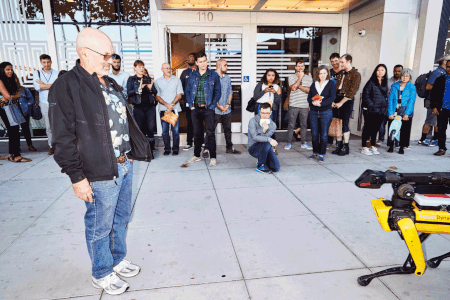You expect too much from the Boston Dynamics robots

At the WIRED25 festival in San Francisco, Robot SpotMini from Boston Dynamics climbed onto the stage and did what the four-robots had not done before: dancing the “ running man ” dance as if it had been created for that. He, of course, moved more like a robot than a human, but this showed how far Spot had advanced in its development: in the twenty-five years of life, WIRED and Boston Dynamics robots finally evolved enough to go through the dance of our world. And they learned to do many more things, of course.
Although the Spot movements are impressive, they include the candid story of Mark Ryberth, the head of Boston Dynamics, who spoke with WIRED editor-in-chief Nicholas Thompson about the opportunities, aspirations and future of Spot and the humanoid Atlas robot.
A few days ago, on the Internet, a video of how Atlas is engaged in parkour, slipping easily into a multi-level structure. Performing the trick seems easy, but it took 20 approaches to do this. But after the robot gets involved, the percentage of successful attempts rises to 90. “In our videos, we usually show the best examples of behavior,” said Rybert. - This is not average and not typical behavior. We consider these examples to be a symbol of what robots can strive for. ”
')
This raises interesting questions. Every time Boston Dynamics releases a video with its opening doors or robots doing a flip , the Internet has a collective heart attack (by the way, Rybbert himself participates in video editing). Machines move with a terrific, almost frightening animal grace, which immediately makes you think about things like robots taking over the world.
In fact, they are so far away from such goals that it will be more productive to talk about how climate change will destroy the planet long before that. If a robot takes 20 attempts to get through the door and catch up with you on the street, it will be very difficult for him to get comfortable.
“Today, robotics is very advanced,” said Rybert, “but it has not yet reached the desired state. I think our job is to continue to expand the boundaries of the possible, as well as to find the best options for using the technology. ”
Yes, of course, these cars look amazing. After the dance, Spot went outside and gathered a crowd around him. People adore this thing, even if it just waddles here and there, collecting bags and hats with its snakelike hand.
But when Spot enters the market next year, consumers should consider that it does not always correspond to what is shown in the video. The company produces Business Spot, not Party Spot [Spot for business, not Spot for parties]. This means that buyers will be able to set up the machine in a certain way, by installing more cameras for surveillance, or special sensors to monitor the construction site. Spot may have a great "running man" dancing, but in essence it is a hard worker who will have to meet the requirements at work and not on the Internet.
Boston Dynamics hopes that Spot will find application in a wide range of industrial areas. But quite a large part of the task of determining where it can come in handy lies with consumers, not the company itself. “We could try to adapt it to something concrete, to a specific decision in one area, but we don’t know which area will be right to concentrate on,” said Rybert. “So we made a platform, and we hope that the ecosystem will help us find places where people can get real benefits from it.”
So far, the idea of SpotMini based on the Internet looks idealistic, although not necessarily unrealistic - the humanoid robots of the company actually do the opposite flip, and their four creatures are able to move autonomously in the environment. The Internet may have turned the machines of Boston Dynamics into god-like creatures, but their future will be determined by the market. So if you are looking for a dance instructor who never gets tired - it's time to say so.
Source: https://habr.com/ru/post/429368/
All Articles